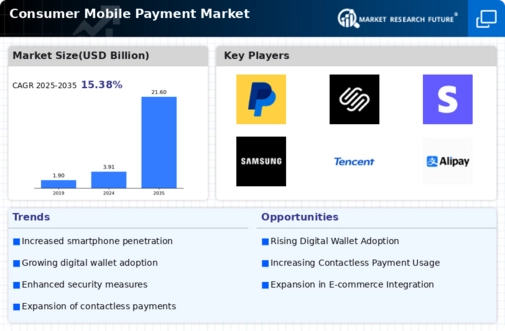The Consumer Mobile Payment Market is currently characterized by a dynamic competitive landscape, driven by rapid technological advancements and evolving consumer preferences. Key players such as Apple (US), Google (US), and Alipay (CN) are at the forefront, each adopting distinct strategies to enhance their market positioning. Apple (US) continues to innovate with its Apple Pay platform, focusing on seamless integration with its ecosystem of devices, while Google (US) emphasizes its Google Pay service by leveraging its extensive data analytics capabilities to personalize user experiences. Alipay (CN), on the other hand, is expanding its reach beyond China, targeting international markets through strategic partnerships, thereby enhancing its global footprint. Collectively, these strategies not only intensify competition but also foster a landscape where innovation and user-centric solutions are paramount.
In terms of business tactics, companies are increasingly localizing their services to cater to regional preferences, which appears to be a critical factor in their success. The market structure is moderately fragmented, with a mix of established players and emerging fintech startups. This fragmentation allows for diverse offerings, yet the influence of major players like PayPal (US) and Square (US) remains substantial, as they continue to set industry standards and drive consumer adoption through robust marketing and user engagement strategies.
In September 2025, PayPal (US) announced a strategic partnership with a leading e-commerce platform to enhance its mobile payment solutions, aiming to streamline the checkout process for users. This move is significant as it not only broadens PayPal's user base but also reinforces its commitment to providing frictionless payment experiences, which is increasingly vital in a competitive market. The partnership is likely to enhance customer loyalty and drive transaction volumes, positioning PayPal favorably against its competitors.
In August 2025, Google (US) launched a new feature within Google Pay that allows users to earn rewards for transactions made at local businesses. This initiative appears to be a strategic effort to bolster user engagement and support local economies, thereby creating a win-win scenario. By incentivizing users to transact with local merchants, Google (US) not only enhances its value proposition but also strengthens its community ties, which could lead to increased market penetration.
In July 2025, Alipay (CN) expanded its services to include cryptocurrency transactions, marking a significant pivot towards digital asset integration. This strategic move is indicative of the growing acceptance of cryptocurrencies in mainstream finance and positions Alipay (CN) as a forward-thinking player in the mobile payment space. By embracing this trend, Alipay (CN) could attract a new demographic of tech-savvy users, further solidifying its competitive edge.
As of October 2025, the competitive trends in the Consumer Mobile Payment Market are increasingly defined by digitalization, sustainability, and the integration of artificial intelligence. Strategic alliances are becoming more prevalent, as companies recognize the value of collaboration in enhancing service offerings and expanding market reach. Looking ahead, competitive differentiation is likely to evolve from traditional price-based strategies to a focus on innovation, technological advancements, and supply chain reliability. This shift underscores the necessity for companies to adapt and innovate continuously in order to maintain relevance in an ever-changing market.

















Leave a Comment